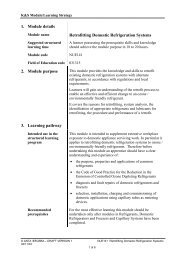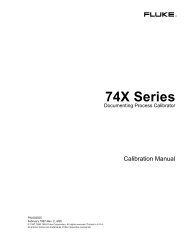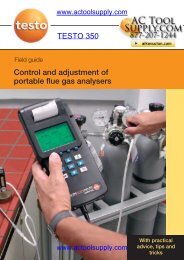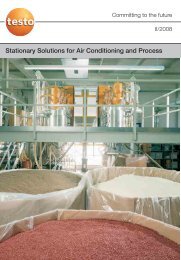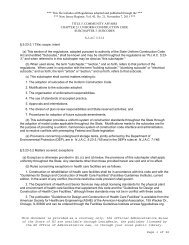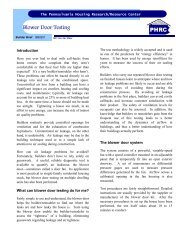Testo 350 Field Guide - Actoolsupply.com
Testo 350 Field Guide - Actoolsupply.com
Testo 350 Field Guide - Actoolsupply.com
You also want an ePaper? Increase the reach of your titles
YUMPU automatically turns print PDFs into web optimized ePapers that Google loves.
www.actoolsupply.<strong>com</strong><br />
Hydrocarbons (C x H y or HC)<br />
Hydrocarbons are an extensive group of chemical <strong>com</strong>pounds that are <strong>com</strong>posed<br />
of hydrogen and carbon. C x H y are the most important substances in organic<br />
chemistry; in nature they are contained in crude oil, natural gas, and coal. Emissions<br />
may occur during production of Hydrocarbon products (e.g. in refineries) as<br />
well as during their use and disposal. Other examples include solvents, plastics,<br />
varnish, vehicle fuels etc. Sources of C x H y emissions are also formed through<br />
in<strong>com</strong>plete <strong>com</strong>bustion processes e.g. forest fires and cigarettes as well. Hydrocarbon<br />
emissions also contribute to the green house effect.<br />
Hydrocarbons include thousand of <strong>com</strong>pounds, methane (CH 4 ), butane C 4 H 10 ),<br />
benzene (C 6 H 6 ), and also carcinogenic <strong>com</strong>pounds such as benzo[a]pyrene. The<br />
total amount of volatile hydrocarbons in a flue gas is often described as "total<br />
hydrocarbon". In emission control normally the value of "total hydrocarbon" is<br />
specified and measured.<br />
Hydrocyanic acid (HCN)<br />
Hydrocyanic acid (known also as prussic acid) is a very toxic liquid with a boiling<br />
point of only 25,6 °C; it may exist in flue gases of incineration plants.<br />
Ammonia (NH 3 )<br />
Ammonia is relevant in flue gases in connection with denitrification plants using<br />
the SCR process. It is fed to the flue gas in exact quantities and causes a<br />
reaction that splits the nitrogen oxides into nitrogen and water. The unconsumed<br />
portion of ammonia is further reduced; its concentration in the clean gas is normally<br />
below 2 mg/m 3 .<br />
Hydrogen halides (HCl, HF)<br />
From <strong>com</strong>bustion of coal and/or waste material the formation of the hydrogen<br />
halides HCl and HF may result which form aggressive acids in humid atmospheres.<br />
These <strong>com</strong>pounds are eliminated almost totally from the flue gas through<br />
scrubbing processes.<br />
Solids (dust, soot)<br />
Solid pollutants in flue gases originate from the in<strong>com</strong>bustible <strong>com</strong>ponents of solid<br />
or liquid fuels. These include oxides of silica, aluminum, and calcium in case of<br />
coal, or sulfates of different elements in case of heavy fuel oil. Dust is dangerous<br />
for human beings as dust particles may be covered with toxic and/or carcinogenic<br />
substances.<br />
18<br />
www.actoolsupply.<strong>com</strong>





